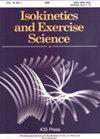监督运动训练对间质性肺病患者运动能力、肺功能和生长分化因子15水平的影响:初步研究
IF 0.7
4区 医学
Q4 ENGINEERING, BIOMEDICAL
引用次数: 0
摘要
背景:间质性肺病以运动性呼吸困难、运动受限和生活质量下降为特征。运动训练在这一多样化患者群体中的作用尚不清楚。生长分化因子15(GDF15)是一种调节全身能量平衡的应激敏感循环因子,可能是间质性肺病的生物标志物。目的:评价有监督运动(耐力和阻力)训练(SET)对间质性肺病(PwILD)患者运动能力、肺功能参数和GDF15水平的影响。方法:在这项非随机病例对照试验中,实验组由10名PwILD(7名女性和3名男性)组成,而对照组由18名明显健康的参与者(11名女性和7名男性)构成。所有受试者都完成了为期8周的有监督的运动训练计划,每周两次。呼吸困难采用呼吸短促问卷进行评估。使用6分钟步行测试测量运动能力,同时在运动训练前后监测心率(HR)。GDF15水平通过酶联免疫吸附测定法(ELISA)测定。结果:在第1次和第15次访视时,PwILD的6分钟步行距离均明显短于对照受试者。然而,两组在这次测试中都有显著的改善。与对照组相比,PwILD的HR值变化(运动前后)较小。此外,与对照组相比,PwILD具有更高的呼吸急促呼吸问卷得分。虽然两组的GDF15前后平均变化值在统计学上保持不变,但与对照组相比,PwILD患者在运动前后训练方面的GDF115值分别显著更高。结论:有监督的运动训练对患者和对照组的GDF15水平没有影响,但其在PwILD中的值明显高于对照组(p⩽0.05)。这些患者的运动能力和呼吸困难在运动训练后有所改善。本文章由计算机程序翻译,如有差异,请以英文原文为准。
Effect of supervised exercise training on exercise capacity, pulmonary function and growth differentiation factor 15 levels in patients with interstitial lung disease: A preliminary study
BACKGROUND: Interstitial lung disease is characterized by exertion dyspnea, exercise limitation and reduced quality of life. The role of exercise training in this diverse patient group is unclear. The growth differentiation factor 15 (GDF15) is a stress-sensitive circulating factor that regulates systemic energy balance and could be a possible biomarker in interstitial lung disease. OBJECTIVE: To evaluate the effect of supervised exercise (endurance and resistance) training (SET) on exercise capacity, pulmonary function parameters and GDF15 levels in patients with interstitial lung disease (PwILD). METHODS: In this non-randomized case-control trial, the experimental group comprised of 10 PwILD (7 women and 3 men) while the control group consisted of of 18 apparently healthy participants s 11 women and 7 men). All subjects completed an 8-week supervised exercise training program, at a rate of twice a week. Dyspnea was evaluated using the Shortness of Breath Respiratory Questionnaire. Exercise capacity was measured using the 6-min walk test while the heart rate (HR) was monitored before and after the exercise training. GDF15 levels were measured by Enzyme-Linked Immunosorbent Assay (ELISA). RESULTS: PwILD had significantly shorter 6-min walk distance than the control subjects at both the 1st and the 15th visit. However, both groups improved significantly in this test. The change (pre to post-exercise) in HR value was smaller in PwILD compared to the controls. Moreover, PwILD had higher Shortness of Breath Respiratory Questionnaire score than controls. While the mean pre-post GDF15 change values in both groups remained statistically unchanged the GDF15 values of the PwILD patients were significantly higher compared to the controls with respect to pre-post exercise training respectively. CONCLUSION: Supervised exercise training did not affect GDF15 levels in both patient and control groups but its values in PwILD were significantly higher compared to those of controls (p⩽0.05). The exercise capacity and dyspnea in these patients improved after exercise training program.
求助全文
通过发布文献求助,成功后即可免费获取论文全文。
去求助
来源期刊

Isokinetics and Exercise Science
医学-工程:生物医学
CiteScore
1.20
自引率
14.30%
发文量
37
审稿时长
>12 weeks
期刊介绍:
Isokinetics and Exercise Science (IES) is an international journal devoted to the study of theoretical and applied aspects of human muscle performance. Since isokinetic dynamometry constitutes the major tool in this area, the journal takes a particular interest in exploring the considerable potential of this technology.
IES publishes studies associated with the methodology of muscle performance especially with respect to the issues of reproducibility and validity of testing, description of normal and pathological mechanical parameters which are derivable from muscle testing, applications in basic research topics such as motor learning paradigms and electromyography. The journal also publishes studies on applications in clinical settings and technical aspects of the various measurement systems employed in human muscle performance research.
The journal welcomes submissions in the form of research papers, reviews, case studies and technical reports from professionals in the fields of sports medicine, orthopaedic and neurological rehabilitation and exercise physiology.
 求助内容:
求助内容: 应助结果提醒方式:
应助结果提醒方式:


